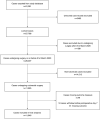Development and internal validation of a model for postoperative morbidity in adults undergoing major elective colorectal surgery: the peri-operative quality improvement programme (PQIP) colorectal risk model
- PMID: 36130834
- PMCID: PMC9826419
- DOI: 10.1111/anae.15858
Development and internal validation of a model for postoperative morbidity in adults undergoing major elective colorectal surgery: the peri-operative quality improvement programme (PQIP) colorectal risk model
Abstract
Over 1.5 million major surgical procedures take place in the UK NHS each year and approximately 25% of patients develop at least one complication. The most widely used risk-adjustment model for postoperative morbidity in the UK is the physiological and operative severity score for the enumeration of mortality and morbidity. However, this model was derived more than 30 years ago and now overestimates the risk of morbidity. In addition, contemporary definitions of some model predictors are markedly different compared with when the tool was developed. A second model used in clinical practice is the American College of Surgeons National Surgical Quality Improvement Programme risk model; this provides a risk estimate for a range of postoperative complications. This model, widely used in North America, is not open source and therefore cannot be applied to patient populations in other settings. Data from a prospective multicentre clinical dataset of 118 NHS hospitals (the peri-operative quality improvement programme) were used to develop a bespoke risk-adjustment model for postoperative morbidity. Patients aged ≥ 18 years who underwent colorectal surgery were eligible for inclusion. Postoperative morbidity was defined using the postoperative morbidity survey at postoperative day 7. Thirty-one candidate variables were considered for inclusion in the model. Death or morbidity occurred by postoperative day 7 in 3098 out of 11,646 patients (26.6%). Twelve variables were incorporated into the final model, including (among others): Rockwood clinical frailty scale; body mass index; and index of multiple deprivation quintile. The C-statistic was 0.672 (95%CI 0.660-0.684), with a bootstrap optimism corrected C-statistic of 0.666 at internal validation. The model demonstrated good calibration across the range of morbidity estimates with a mean slope gradient of predicted risk of 0.959 (95%CI 0.894-1.024) with an index-corrected intercept of -0.038 (95%CI -0.112-0.036) at internal validation. Our model provides parsimonious case-mix adjustment to quantify risk of morbidity on postoperative day 7 for a UK population of patients undergoing major colorectal surgery. Despite the C-statistic of < 0.7, our model outperformed existing risk-models in widespread use. We therefore recommend application in case-mix adjustment, where incorporation into a continuous monitoring tool such as the variable life adjusted display or exponentially-weighted moving average-chart could support high-level monitoring and quality improvement of risk-adjusted outcome at the population level.
Keywords: colorectal surgery; monitoring; morbidity; quality improvement; risk-adjustment.
© 2022 The Authors. Anaesthesia published by John Wiley & Sons Ltd on behalf of Association of Anaesthetists.
Figures


Comment in
-
Predicting morbidity in colorectal surgery: one step on the way to improving outcomes?Anaesthesia. 2022 Dec;77(12):1332-1335. doi: 10.1111/anae.15872. Epub 2022 Oct 4. Anaesthesia. 2022. PMID: 36196012 No abstract available.
References
-
- Abbott TEF, Fowler AJ, Dobbs TD, Harrison EM, Gillies MA, Pearse RM. Frequency of surgical treatment and related hospital procedures in the UK: a national ecological study using hospital episode statistics. British Journal of Anaesthesia 2017; 119: 249–57. - PubMed
MeSH terms
Grants and funding
LinkOut - more resources
Full Text Sources
Medical

